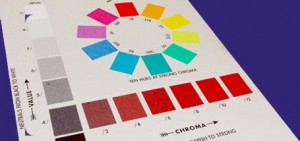
Busy about the business of selling his color crayons, spheres, photometers and enamels (color samples) in addition to his book, A Color Notation, Albert H. Munsell begins to set up a dealer network to market and sell his color education tools. Munsell also continues to practice painting, including a portrait of colleague and advisor, Professor Amos Dolbear (Tufts University). The portrait was entitled, “The Inventor.”
Color Tools for Education: Munsell Sets the Record Straight
During this time—circa 1906—Munsell’s color education business began to take off with schools placing orders for crayons, color spheres, books and related teaching aids. It’s important to note that Munsell oversaw the development of his color education tools. Munsell used his photometer to scientifically vet the pigments and final colors to ensure each color accurately represented the relationship of Hue, Value and Chroma attributes described in his Color Order System.
So when Walter Sargent tried to pass off his “School Arts Box” as a teaching aid for children, Munsell turned to his photometer and scientific theory (including Munsell’s own color theory) to refute Sargent’s claim.
Sargent’s three pairs of complementary colors included: red and green; orange and blue; and yellow and violet, and according to Sargent were “all of same intensity arranged in equal steps of value and hue.” Using his hue circle, Munsell pointed out that Sargent’s pairs were not complementary and did not follow Munsell’s equally stepped visual hue circle. In fact, Munsell argued that orange was “twice too large and out of place” to be a complement and suggested Sargent remove it from the box.
Further measurement of Sargent’s colors detected excess of yellow and also an imbalance in value leaving Munsell to the conclusion that Sargent’s colors were “unbalanced in every way, H.V.C.!” and “all shows ignorance of color.” Ouch!
It was A.H. Munsell’s attention to scientific details and his respect for the color theories of his predecessors that have contributed to the longevity of the Munsell Color Order system. The continued use of Munsell color education products today represents the significant contribution of A. H. Munsell to modern color measurement[DC1] . Perhaps this 1907 letter from A. E. Winship of the Massachusetts Board of Education sums up A. H. Munsell’s contribution:
“Gentlemen: It was a rare privilege to spend a half day in the studio of A. H. Munsell, enjoying his unfolding of the development during the last fifteen years of a scientific color scheme by which pigment colors can be recorded, remembered and reproduced with almost geometrical precision. I had read his book, “A Color Notation,” but not until I had looked into his photometer and followed the development of his color globe and color charts, did it appeal to me as an important discovery. Unless all signs fail, Mr. Munsell has added a step in the scientific development of Maxwell, Helmholtz, and Rood. It is nearly fifty years since Maxwell challenged the theories of Brewster. Helmholtz improved upon Maxwell’s presentation of the case, and in 1879 Rood’s “Modern Chromatics” opened up a new order of things; but it has been left to Munsell to give a complete scientific development of a measured color system.
Learn how Munsell color education products can help you gain a better understanding of the practical application of Munsell Color Theory to improve color communications and control.
References:
H. Munsell Color Diary, 1908-1918, Volume A Part 10 (pp. 192-194) and Volume A Part 11 (page 213). Courtesy of Rochester Institute of Technology, Munsell Color Science Laboratory.
Diary a volume 10 circa 1906



Leave a Reply